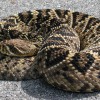 Snakes provide numerous benefits to people and to the environment, by controlling rat and mice populations in the environment, for example. Or in the laboratory, where pygmy rattlesnake venom research helped develop medicine to thin the blood of heart attack patients. Most snakes are secretive and rarely bother people, but there are situations where some snakes can become dangerous. In this 4-page fact sheet, we present some facts about snakes, describe dangers they may cause, and provide suggestions on how to cope with these dangers. Written by Holly K. Ober, Steve Johnson, and William M. Giuliano, and published by the UF Department of Wildlife Ecology and Conservation, November 2014. (Photo: Steve Johnson)
Snakes provide numerous benefits to people and to the environment, by controlling rat and mice populations in the environment, for example. Or in the laboratory, where pygmy rattlesnake venom research helped develop medicine to thin the blood of heart attack patients. Most snakes are secretive and rarely bother people, but there are situations where some snakes can become dangerous. In this 4-page fact sheet, we present some facts about snakes, describe dangers they may cause, and provide suggestions on how to cope with these dangers. Written by Holly K. Ober, Steve Johnson, and William M. Giuliano, and published by the UF Department of Wildlife Ecology and Conservation, November 2014. (Photo: Steve Johnson)
http://edis.ifas.ufl.edu/uw395
Tag: Snakes
Quick Reference Guide: Native Snakes Easily Mistaken for Introduced Constrictors in Florida (WEC305/UW350)
Three non-native species of large constrictor snakes are now breeding in Florida, and several others have been encountered but have not yet established wild populations. This quick reference guide to identification of the native snakes you might easily mistake for introduced constrictors in Florida was written by Steve A. Johnson and Monica E. McGarrity, and published by the UF Department of Wildlife Ecology and Conservation, Januar 2011.
http://edis.ifas.ufl.edu/uw350
WEC302/UW347 Quick Reference Guide: Introduced Constrictors in Florida
WEC302, a 2-page fact sheet by Steve A. Johnson and Monica E. McGarrity, is a quick reference guide to identification of the constrictors one is most likely to encounter in Florida. Published by the UF Department of Wildlife Ecology and Conservation, November 2010.
http://edis.ifas.ufl.edu/uw347
WEC251/UW296 The Florida Pinesnake: Pituophis melanoleucus mugitus
WEC-251, a 6-page illustrated fact sheet by Gabriel J. Miller, Steve A. Johnson, Lora L. Smith, and Joseph W. Jones, describes this large, handsome, heavy-bodied snake with dark brown or rust-colored blotches on a light cream to tan background — similar species, distribution and habitats, behavior, diet, reproduction, and conservation. Includes references. Published by the UF Department of Wildlife Ecology and Conservation, February 2009.
http://edis.ifas.ufl.edu/UW296
WEC242span/UW288 Pitones Birmanas en Florida del Sur: Soporte Científico para el Manejo de Especies Invasoras
WEC-242-Span, a 10-page illustrated fact sheet by Rebecca G. Harvey, Matthew L. Brien, Michael S. Cherkiss, Michael Dorcas, Mike Rochford, Ray W. Snow, and Frank J. Mazzotti and translated by Marianna Domínguez, is the Spanish language version of WEC-242, Burmese Pythons in South Florida: Scientific Support for Invasive Species Management. It describes the population of Burmese pythons in south Florida, python reproduction, size and appearance, and the work of the Python Science Support Team. Includes information about how Florida residents can help prevent the spread of invasive snakes, and references. Published by the UF Department of Wildlife Ecology and Conservation, May 2008.
http://edis.ifas.ufl.edu/UW288